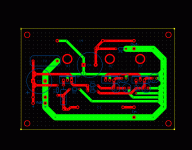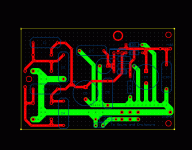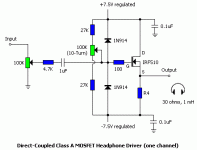Hi all!
I'm new here. This forum looks great 🙂 I hope I'll find my answears here.
I'm going to build my first audio DIY project: a szekeres amp
First: I choose the szekeres because of it's simple design, and I've heard it sounds good. I'll use it for a Sennheiser HD565 on a computer (with sblive).
Is this a good choice? Or do better amps exist (better and not really more complicated) ?
Do you have some advices on the szekers model that sound the best? (DC coupled; CCS...)
My first choice is to build the latest one that is on headwise's site: (if nobody tells me it's a poor choice)
http://headwize2.powerpill.org/projects/showproj.php?file=szeke1_prj.htm
Now, I'm working on the PS. I've heard the szekeres are very sensible to ps quality, anr ripples. So I'm going to buils th PS myself, and not buy a regulated PS (a friend gave me a torroid transformer 2 days ago, so I haven't to buy the main part)
I'm thinking about using this model:
It's a ZenV4 PS. IMHO the design is good. But the values (especially for the condensers) are to be changed.
The problem is: how much will be good?
The transformer is a 230V (primary) 12V (secondary) 50VA. Will it be enough to drive a stereo szekeres?
What do you think about all this?
Can you give me some good values for the condensers?
Thanks a lot 🙂
I'm new here. This forum looks great 🙂 I hope I'll find my answears here.
I'm going to build my first audio DIY project: a szekeres amp
First: I choose the szekeres because of it's simple design, and I've heard it sounds good. I'll use it for a Sennheiser HD565 on a computer (with sblive).
Is this a good choice? Or do better amps exist (better and not really more complicated) ?
Do you have some advices on the szekers model that sound the best? (DC coupled; CCS...)
My first choice is to build the latest one that is on headwise's site: (if nobody tells me it's a poor choice)
http://headwize2.powerpill.org/projects/showproj.php?file=szeke1_prj.htm
An externally hosted image should be here but it was not working when we last tested it.
Now, I'm working on the PS. I've heard the szekeres are very sensible to ps quality, anr ripples. So I'm going to buils th PS myself, and not buy a regulated PS (a friend gave me a torroid transformer 2 days ago, so I haven't to buy the main part)
I'm thinking about using this model:
An externally hosted image should be here but it was not working when we last tested it.
It's a ZenV4 PS. IMHO the design is good. But the values (especially for the condensers) are to be changed.
The problem is: how much will be good?
The transformer is a 230V (primary) 12V (secondary) 50VA. Will it be enough to drive a stereo szekeres?
What do you think about all this?
Can you give me some good values for the condensers?
Thanks a lot 🙂
great 🙂
thanks for answearing so fast!
Your amp looks really good!
I sea (at least) 5 capacitors per channel. What are they for?
The picture i've posted only recommends 3
What kind of PS are you using, Jean?
thanks for answearing so fast!
Your amp looks really good!
I sea (at least) 5 capacitors per channel. What are they for?
The picture i've posted only recommends 3
What kind of PS are you using, Jean?
Two caps in the middle are C2 1000uF Elna caps. Four blue caps are ps caps 4700uF caps. I am going to use regulated PS, 50va avel tranny 18volt x 2 and 2 LM317T (to220 package) voltage regulators. Regulators and misc components should arrive soon 🙂
P.S. I used a cheap 12 volt power supply for testing the board.
P.S. I used a cheap 12 volt power supply for testing the board.
Your transformer looks good to me but I have no experience with class A power supplies.
At 15 volts the max current draw is 1.26A (by my calculations) This is low enough that you may be able to get away with a simple IC voltage regulator. I don't know how it will sound, but it seems to me as good or better than the radioshack power supply. 15V may be a little close to the transformers output (with rectifier diodes factored it) and mains droop may do you in. If you go with 12V supply the current demand drops to about 1A. This should be possible with the regulator on a fair sized heat sink. Those regs have huge ripple rejection and since the current requirements should be fairly constant that shouldn't create a problem either. I would look something like an lm7812.
(next post was up befoe i finished mine)
edit:
lm317 is in the same family as the lm7812, but is adjustable. It takes a few more external parts, but any output voltage is possible. Seems like this would be the way to go.
At 15 volts the max current draw is 1.26A (by my calculations) This is low enough that you may be able to get away with a simple IC voltage regulator. I don't know how it will sound, but it seems to me as good or better than the radioshack power supply. 15V may be a little close to the transformers output (with rectifier diodes factored it) and mains droop may do you in. If you go with 12V supply the current demand drops to about 1A. This should be possible with the regulator on a fair sized heat sink. Those regs have huge ripple rejection and since the current requirements should be fairly constant that shouldn't create a problem either. I would look something like an lm7812.
(next post was up befoe i finished mine)
edit:
lm317 is in the same family as the lm7812, but is adjustable. It takes a few more external parts, but any output voltage is possible. Seems like this would be the way to go.
LM317 constant current source
Here is Tomo version
in an earlier post at Diyaudio forum.
Szekeres a la Tomo
This picture is also on Headwize.
Here is Tomo version
in an earlier post at Diyaudio forum.
Szekeres a la Tomo
This picture is also on Headwize.
Hi Bricolo,
Have a read of this article:
http://sound.westhost.com/project36.htm
before you construct the Szkeres amp.
The distortion of such a basic circuit is likely to be very high - around 2%. Maybe you could consider Rod Elliott's revised project instead:
http://sound.westhost.com/project70.htm
Hope this helps,
Tim.
Have a read of this article:
http://sound.westhost.com/project36.htm
before you construct the Szkeres amp.
The distortion of such a basic circuit is likely to be very high - around 2%. Maybe you could consider Rod Elliott's revised project instead:
http://sound.westhost.com/project70.htm
Hope this helps,
Tim.
On the topic of this amp, im finding the IRF510/512/513 hard to find.
Can anyone sugest a commonly found MOSFET to replace them?
Can anyone sugest a commonly found MOSFET to replace them?
IRF610 is easier to find, I hope.
And of course such an amplifier can be designed with some TO220 Bipolar,
like MJE15030 (or is it MJE15031, being NPN?)
Should in my opinion not sound any worse,
more probable better, I guess.(lower distortion)
And of course such an amplifier can be designed with some TO220 Bipolar,
like MJE15030 (or is it MJE15031, being NPN?)
Should in my opinion not sound any worse,
more probable better, I guess.(lower distortion)
The Szekeres you've shown should draw (I think) around 350 mA per channel, 0.7A for two channels. At 15VDC, this would be 10.5 watts DC. A rule of thumb is to double DC watts to get AC VA, so you need 21 VA. Your 50VA should be more than enough.Bricolo said:The transformer is a 230V (primary) 12V (secondary) 50VA. Will it be enough to drive a stereo szekeres?
You need a reasonable sized heatsink, and mounting of the transistor is critical to ensure good thermal contact. Headwize should have plenty of examples of Szekeres amps.
You can experiment with adding regulators, but my preference is a capacitance multiplier. You don't really need regulation, you need smoothing. See www.sound.au.com for one such project. I suggest one multiplier or regulator per channel.
Here is an image of the regulated supply PCB. I don't have the diagram for this one yet. I took the Welborne Labs PS1 diagram and just used the positive half. It's basically a Jung regulator. They are made using ExpressPCB and each is layed out on a "miniboard". You can get three of each board for $120 USD. Less if there are others that want a set of boards and you do a group purchase. The way things look with my hobby funding I may never get to use the boards or the design so I figure that somebody should. Just email me if you want the files and I will send them to you. Oh,by the way The Szekeras is really meant to drive lo impedance loads. If you want to use Sennheiser HD580's a good Cmoy or Meta is all that you will need.
G
G
Attachments
Thanks all! 🙂
Your advices and links helped me a lot.
After having read more than 50 web pages (!!!) I think i'll go for the classical szekeres amp (the one i've put on my first post)
Maybe I'll go later for the CCS one.
More linear amps like the DOZ will be too dificult to build for a first diy project.
I'll maybe build a Zen, with speakers, later.
For the PS, i'll also use the picture i've posted, with those values:
100nF for the primary
1*4700µF instead of each 2*15000µF
2.2mH for the self (I've kept the original value, i think it isn't optimal, but I've found no infos about values for a Pi filter)
4.7µF for the last condenser
and maybe a 100nF capa in parallel with each gate's diode
Wants someone add something?
Your advices and links helped me a lot.
After having read more than 50 web pages (!!!) I think i'll go for the classical szekeres amp (the one i've put on my first post)
Maybe I'll go later for the CCS one.
More linear amps like the DOZ will be too dificult to build for a first diy project.
I'll maybe build a Zen, with speakers, later.
For the PS, i'll also use the picture i've posted, with those values:
100nF for the primary
1*4700µF instead of each 2*15000µF
2.2mH for the self (I've kept the original value, i think it isn't optimal, but I've found no infos about values for a Pi filter)
4.7µF for the last condenser
and maybe a 100nF capa in parallel with each gate's diode
Wants someone add something?
Just make sure to use good low impedance capacitors in the power supply and on the output and have fun. Let us know how it turns out.
G
G
I'd like to try this
A bipolar buffer amp for Headphones.
With BC550C driving a MJE15030(PNP)
in FOLDBACK.
Say we let BC550 have some 5-10 mA currents.
And the MJE15030 having 100 mA. Would be enough for most.
And same as a constant current source.
Use an BC550, amplified diode mode, as referens
Polypropylen for input.
Say 10-20 kOhm input impedance.
Not fond of 47-100 kohm.
Most sources wouldn't suffer from 10 kohm.
And then a pair of OSCON caps, in parallell, for output.
For supply I'd use DC-source. One or two 12 V Car-batteries
See this thread:
http://www.diyaudio.com/forums/showthread.php?goto=newpost&threadid=7519
Couldn't be bad.
Could turn out to be real good.
--------------------------------------------------------------
No exotic components. With the magic letters "FET".
People like to beleive in magic. Gold fever!
But "exotic" is not the same as superior or good.
If gold was to find everywhere around your house
it wouldn't be expensive, or desirable/expensive.
But it would still be gold!
Bipolar is to be found anywhere.
They have lost the exotic label, they had when they first arrived.
But they still are better choice for some applications
than anything with FET in its name.
Different devices have their strenghts and shortcomings.
Used in their right place, they do the job best.
In the wrong application, they do not do an optimal job.
A bipolar buffer amp for Headphones.
With BC550C driving a MJE15030(PNP)
in FOLDBACK.
Say we let BC550 have some 5-10 mA currents.
And the MJE15030 having 100 mA. Would be enough for most.
And same as a constant current source.
Use an BC550, amplified diode mode, as referens
Polypropylen for input.
Say 10-20 kOhm input impedance.
Not fond of 47-100 kohm.
Most sources wouldn't suffer from 10 kohm.
And then a pair of OSCON caps, in parallell, for output.
For supply I'd use DC-source. One or two 12 V Car-batteries
See this thread:
http://www.diyaudio.com/forums/showthread.php?goto=newpost&threadid=7519
Couldn't be bad.
Could turn out to be real good.
--------------------------------------------------------------
No exotic components. With the magic letters "FET".
People like to beleive in magic. Gold fever!
But "exotic" is not the same as superior or good.
If gold was to find everywhere around your house
it wouldn't be expensive, or desirable/expensive.
But it would still be gold!
Bipolar is to be found anywhere.
They have lost the exotic label, they had when they first arrived.
But they still are better choice for some applications
than anything with FET in its name.
Different devices have their strenghts and shortcomings.
Used in their right place, they do the job best.
In the wrong application, they do not do an optimal job.
Bricolo,
"More linear amps like the DOZ will be too dificult to build for a first diy project."
Rod sells boards for the DOZ headphone amp if you are concerned about difficulty, I would give it some further consideration. The distortion figures of the Szkeres amp are likely to be quite poor - it is easy to improve on them. Also, bear in mind a classic "cmoy" op-amp based headphone amplifier is more foolproof and cheaper to build than the Szkeres.
Whatever you build, have fun with your first DIY project!
Tim.
"More linear amps like the DOZ will be too dificult to build for a first diy project."
Rod sells boards for the DOZ headphone amp if you are concerned about difficulty, I would give it some further consideration. The distortion figures of the Szkeres amp are likely to be quite poor - it is easy to improve on them. Also, bear in mind a classic "cmoy" op-amp based headphone amplifier is more foolproof and cheaper to build than the Szkeres.
Whatever you build, have fun with your first DIY project!
Tim.
Simple is good
Bricolo,
I like your simple design. It will sound better if you can use a split rail supply (can you?). This will allow you to eliminate R1,R2,R3. You can ditch the diodes. The input cap should go upstream of the potentiometer. This is simpler and will reduce psu noise and distortion from being added to the input signal via the bias resistors. If you cannot use a split rail supply then make sure your psu is very good.
BAM
PS: Where does this name "Szekeres" come from? This is just a simple source follower - been used since the beginning of time.
Bricolo,
I like your simple design. It will sound better if you can use a split rail supply (can you?). This will allow you to eliminate R1,R2,R3. You can ditch the diodes. The input cap should go upstream of the potentiometer. This is simpler and will reduce psu noise and distortion from being added to the input signal via the bias resistors. If you cannot use a split rail supply then make sure your psu is very good.
BAM
PS: Where does this name "Szekeres" come from? This is just a simple source follower - been used since the beginning of time.
G. Szekeres
It comes from this member. See link below.
Years ago he published his own project.
since then many have liked it. So many that his construction is famous.
Similar story have Nelson Pass.
Before his amplifiers he was unknown.
Next in line could be "traderbam":
- Have you heard my new version of traderbam Amp.
- Yes. Now I will build my own.
http://www.diyaudio.com/forums/member.php?s=&action=getinfo&userid=2734
It comes from this member. See link below.
Years ago he published his own project.
since then many have liked it. So many that his construction is famous.
Similar story have Nelson Pass.
Before his amplifiers he was unknown.
Next in line could be "traderbam":
- Have you heard my new version of traderbam Amp.
- Yes. Now I will build my own.
http://www.diyaudio.com/forums/member.php?s=&action=getinfo&userid=2734
- Home
- Amplifiers
- Headphone Systems
- DIY Power supply for a Szekeres headphone amp



